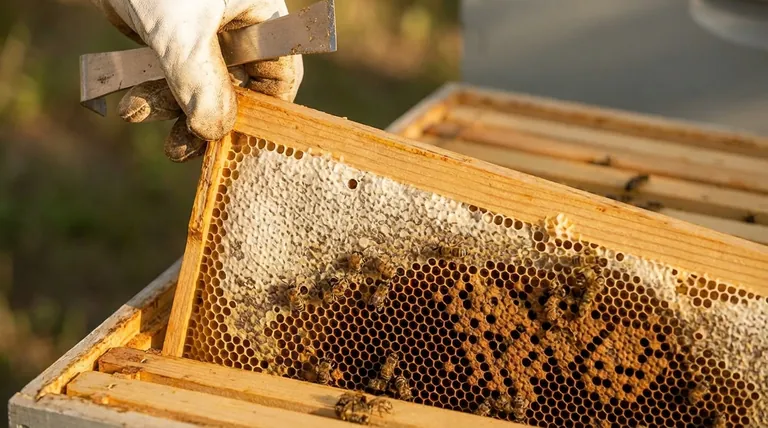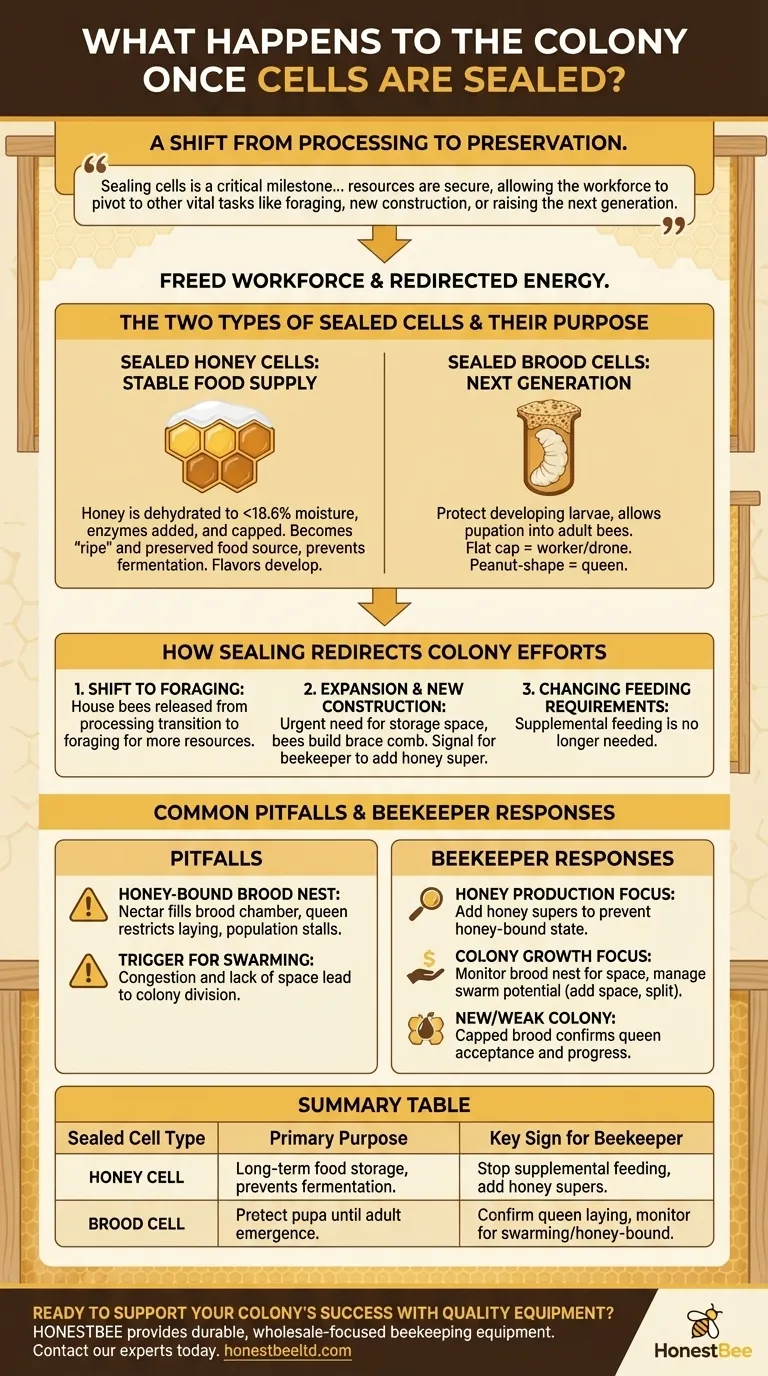In short, once cells are sealed, the colony's work on those specific cells is complete, marking a shift from processing to preservation. This frees up the workforce for other tasks and signals to the beekeeper that the colony no longer needs supplemental feeding for that purpose. The contents, whether honey or a developing bee, are now secure for their long-term function.
Sealing cells is a critical milestone that transitions the colony's focus from filling and processing to long-term storage and expansion. This event indicates that resources are secure, allowing the workforce to pivot to other vital tasks like foraging, new construction, or raising the next generation of bees.

The Two Types of Sealed Cells and Their Purpose
When bees seal a cell, they are completing a specific biological process. The type of cell they seal dictates the future of the colony, determining either its food supply or its population.
Sealed Honey Cells: Creating a Stable Food Supply
Bees cap honey with a pristine layer of white beeswax only after the nectar has been fully converted. This involves dehydrating the nectar to below 18.6% moisture and adding enzymes from their own bodies.
Once sealed, this honey is considered "ripe." It is now a stable, preserved food source that will not ferment, ready to sustain the colony through winter or a period of dearth. This capping process also allows the unique flavors of the honey to fully develop.
Sealed Brood Cells: The Next Generation of Bees
Bees also seal cells containing developing larvae. After a larva has been fed for several days, worker bees cap its cell with a porous mixture of wax and pollen.
Inside this protected chamber, the larva spins a cocoon and pupates, transforming into an adult bee. A flat, slightly convex cap indicates a worker or drone bee, while a distinctive, peanut-shaped cell is the unmistakable sign of a developing queen.
How Sealing Cells Redirects the Colony's Efforts
A hive full of sealed cells is not an idle one. This milestone is a trigger that redirects the collective energy of the colony toward new objectives.
A Shift From Processing to Foraging
The house bees responsible for dehydrating nectar and capping cells are now free for other duties. During a strong nectar flow, many of these bees will transition to foraging, increasing the colony's power to bring in more resources.
Expansion and New Construction
If bees are capping honey and the nectar flow continues, they will urgently seek new space for storage. They will begin building brace comb in any available open space, connecting frames or filling gaps.
For the beekeeper, this is a clear signal that the colony is strong, growing, and likely needs more room, such as an additional honey super.
A Change in Feeding Requirements
As the references note, once a colony begins sealing its own food stores, it no longer needs supplemental feeding. They have successfully gathered and stored their own resources.
Continuing to feed a colony that is already capping honey is unnecessary and can create significant problems.
Understanding the Common Pitfalls
While sealed cells are a sign of success, they also present new challenges that a beekeeper must manage to prevent the colony's progress from stalling.
The Risk of a Honey-Bound Brood Nest
If a very strong nectar flow coincides with limited space, bees may fill the brood chamber with nectar and cap it as honey. This is known as becoming honey-bound.
When this happens, the queen runs out of room to lay eggs, which can severely restrict or even halt the growth of the colony's population.
The Trigger for Swarming
A strong, populous colony that is rapidly filling all available space is a colony preparing to swarm. Sealing large amounts of brood and honey are classic precursors to this event.
Congestion and a lack of space for the queen to lay are primary swarm triggers. The beekeeper must be vigilant for these signs to prevent losing half their bees.
How to Respond as a Beekeeper
Observing sealed cells allows you to make informed management decisions that align with the colony's natural cycle and your own beekeeping goals.
- If your primary focus is honey production: Seeing capped honey means it is time to add another honey super to provide more storage space and prevent the hive from becoming honey-bound.
- If your primary focus is colony growth: Monitor the brood nest to ensure it has ample space for the queen to lay, and be prepared to manage swarm potential by adding space or making a split.
- If you are managing a new or weak colony: The first sight of capped brood is a key indicator of success, confirming the queen is accepted, laying well, and the colony is establishing itself.
By understanding what sealed cells signify, you can move from simply keeping bees to actively guiding their health and productivity.
Summary Table:
| Sealed Cell Type | Primary Purpose | Key Sign for the Beekeeper |
|---|---|---|
| Honey Cell | Long-term food storage; prevents fermentation. | Stop supplemental feeding; add honey supers for production. |
| Brood Cell | Protect developing bee (pupa) until it emerges as an adult. | Confirm queen is laying; monitor for swarming or honey-bound conditions. |
Ready to support your colony's success with the right equipment?
Sealed cells are a sign of a thriving hive, but managing that growth requires quality supplies. Whether you're a commercial apiary scaling up production or a distributor stocking reliable gear, HONESTBEE provides the durable, wholesale-focused beekeeping equipment you need to capitalize on your hive's productivity.
Contact our experts today to discuss your specific needs and ensure your operation is built for success.
Visual Guide

Related Products
- HONESTBEE Advanced Ergonomic Stainless Steel Hive Tool for Beekeeping
- Professional Dual-End Stainless Steel Hive Tool for Beekeeping
- Professional 3-Bar Frame Grip with Integrated Hive Tool
- Beehive Handle and Frame Rest Cutting Machine: Your Specialized Hive Machine
- Professional Engraved Round Hive Number Tags for Beekeeping
People Also Ask
- What are some common uses of a hive tool? Essential Multi-Purpose Tool for Every Beekeeper
- Why is it important to compare the progress of different hives? A Beekeeper's Key Diagnostic Tool
- How should beekeepers handle bees when using a hive tool? Master Calm, Deliberate Techniques
- What are the basic tools for beekeeping? Essential Starter Kit for Safe & Successful Hive Management
- How is a hive tool used for scraping and cleaning? Master Hive Maintenance for a Healthy Colony



















